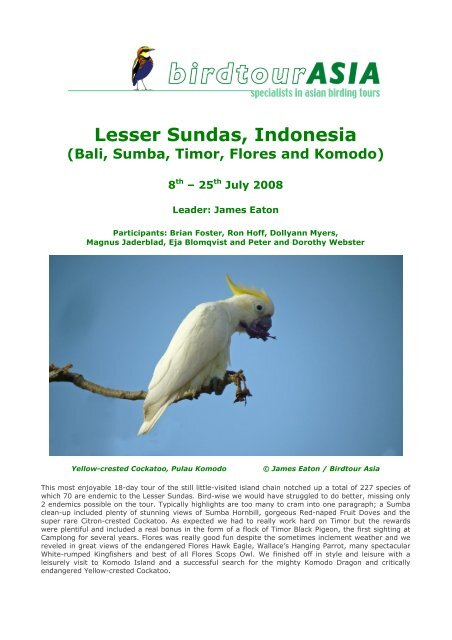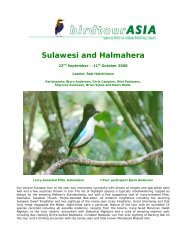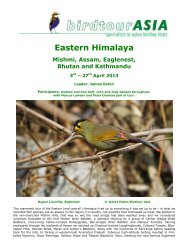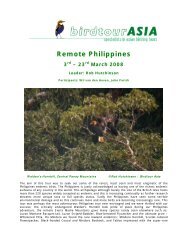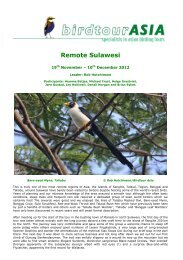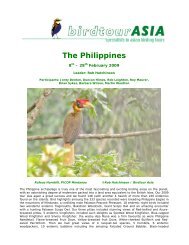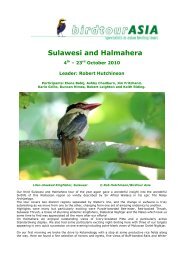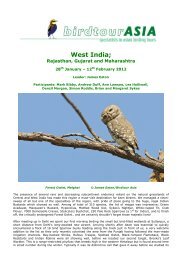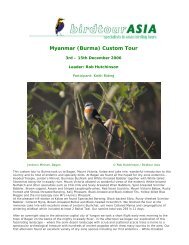Lesser Sundas, Indonesia - Birdtour Asia
Lesser Sundas, Indonesia - Birdtour Asia
Lesser Sundas, Indonesia - Birdtour Asia
You also want an ePaper? Increase the reach of your titles
YUMPU automatically turns print PDFs into web optimized ePapers that Google loves.
<strong>Lesser</strong> <strong>Sundas</strong>, <strong>Indonesia</strong><br />
(Bali, Sumba, Timor, Flores and Komodo)<br />
8 th – 25 th July 2008<br />
Leader: James Eaton<br />
Participants: Brian Foster, Ron Hoff, Dollyann Myers,<br />
Magnus Jaderblad, Eja Blomqvist and Peter and Dorothy Webster<br />
Yellow-crested Cockatoo, Pulau Komodo © James Eaton / <strong>Birdtour</strong> <strong>Asia</strong><br />
This most enjoyable 18-day tour of the still little-visited island chain notched up a total of 227 species of<br />
which 70 are endemic to the <strong>Lesser</strong> <strong>Sundas</strong>. Bird-wise we would have struggled to do better, missing only<br />
2 endemics possible on the tour. Typically highlights are too many to cram into one paragraph; a Sumba<br />
clean-up included plenty of stunning views of Sumba Hornbill, gorgeous Red-naped Fruit Doves and the<br />
super rare Citron-crested Cockatoo. As expected we had to really work hard on Timor but the rewards<br />
were plentiful and included a real bonus in the form of a flock of Timor Black Pigeon, the first sighting at<br />
Camplong for several years. Flores was really good fun despite the sometimes inclement weather and we<br />
reveled in great views of the endangered Flores Hawk Eagle, Wallace’s Hanging Parrot, many spectacular<br />
White-rumped Kingfishers and best of all Flores Scops Owl. We finished off in style and leisure with a<br />
leisurely visit to Komodo Island and a successful search for the mighty Komodo Dragon and critically<br />
endangered Yellow-crested Cockatoo.
We all gathered first on Bali, the ‘island of the Gods’, and we managed to fit in a couple of little excursions<br />
to bump up our lists. Firstly, Bedugul Botanical Gardens nestled high in the hills produced a nice variety of<br />
new birds for all of us. Birding around the gates at first light was great, <strong>Indonesia</strong>n Honeyeater was<br />
extremely common feeding lowdown in the bottlebrush, large numbers of Grey-cheeked Green Pigeon<br />
buried themselves amongst the berries in the car park and flocks of Short-tailed Starlings betrayed their<br />
presence by continually chirping overhead. We gradually gained height as we reached less disturbed<br />
habitats where species composition changed (and dried up!), Blood-breasted Flowerpecker and Spotbreasted<br />
Woodpecker were a continual sight and sound, along with the honeyeaters and a Flame-fronted<br />
Barbet which took some finding before performing along with a beautiful male Golden Whistler. Our<br />
second excursion took us to the south coast for some sea-watching at Ulu Watu Temple. Within 5 minutes<br />
of leaving the car a big bonus appeared in the form of 6 Black-winged Myna hedge-hopped their way<br />
through a small valley and away along with the increasingly rare (on their native grounds anyway) Javan<br />
Myna. Scanning the choppy water for a couple of hours was most enjoyable especially when the Whitetailed<br />
Tropicbird, picked up 500m out to sea flew straight in and landed on the white cliffs directly below<br />
us! Wedge-tailed Shearwaters appeared among the large numbers of Streaked Shearwater along with<br />
other fly-bys including Brown Booby and Bridled Terns. The surrounding bushes kept us equally<br />
entertained; Pink-necked Green Pigeon, White-shouldered Triller, Bar-winged Prinia, Barred Buttonquail<br />
and Chestnut-headed Bee-eater all added themselves to the impressive morning.<br />
Sumba Boobook and Sumba Hornbill, Sumba © James Eaton<br />
Eventually the ‘real’ birding got underway as we landed into Waingapu, the capital of Sumba Island.<br />
Spending 3 nights with our wonderful hosts, we couldn’t have done much better as we completely<br />
cleaned-up on all the endemics. In fact, we had found all but two of the endemics by the end of our first<br />
morning! Night-birding straight from the airport proved a wise decision as both the wonderfully marked<br />
Sumba Boobook and recently-described Little Sumba Boobook shone beautifully in the spotlight, especially<br />
the former as a pair duetted together just overhead. The following evening we completed the night-birding<br />
with the recently described Mees’s Nightjar hawking low overhead. Most surprising was the Barn Owl, an<br />
endemic race, we found roosting outside its presumed nest-hole in the heart of the forest giving wonderful<br />
views of this species.<br />
We split our time between two forest patches, both sites were very much enjoyed. Our first site, birding<br />
along a main road through good forest, turned up trumps with all the forest endemics encountered and<br />
seen by all of us. A huge fruiting tree must have been close by as both the regal Sumba Hornbill and<br />
spectacular Red-naped Fruit Dove proved unusually co-operative on both visits sitting out on open<br />
branches in the early morning sunlight. Other frugivores were also reasonably conspicuous as Sumba<br />
Green Pigeon, Metallic Pigeon, Black-naped Fruit Dove and a host of parrots all performed. Of the parrots<br />
the expected Marigold Lorikeet’s were typically noisy, flying around in small groups occasionally landing<br />
and providing a huge source of entertainment with their various branch-swinging antics. Our final morning<br />
here was quite something else; in just 20 minutes we recorded 44 Great-billed Parrots tree-hopping along<br />
a ridge along with 5 Electus Parrots and most amazingly 3 Citron-crested Cockatoo, a critically<br />
endangered species that appears all but doomed unless drastic action is taken to protect this charismatic<br />
species. The cockatoo’s were even more welcome as the previous days visit to another forest patch in<br />
search of this species had resulted only in distant perched views for most of us. Winding our way down<br />
this wonderful forested valley produced our other endemics; Apricot-breasted Sunbird was typically<br />
common as was Pale-shouldered Cicadabird, the trio of tricky endemic flycatchers fortunately all showed
well, including super views of shy Sumba as well as canopy loving Sumba Brown and somber looking<br />
Sumba Jungle Flycatcher (a split from Flores Jungle), fiery-red Sumba Myzomela, Yellow-spectacled and<br />
Ashy-bellied White-eyes, Golden Whistler, the distinctive endemic race of Blood-breasted Flowerpecker<br />
(another potential split?), less-pretty Helmeted Friarbirds, Cinnamon-banded Kingfisher and a close Rustybreasted<br />
Cuckoo. During our regular forays inside the forest chasing Elegant Pittas we sat quietly<br />
obtaining several wonderful looks at Chestnut-backed Thrush, one of the most attractive zoothera,<br />
especially when seen this well.<br />
A visit to a larger forest patch much further afield in search of the previously mentioned cockatoo was a<br />
real hive of activity in the early morning, amazingly we recorded more than 25 Sumba Hornbill including a<br />
single flock of 15 tree-hopping as they left a fruiting tree that was dripping in Sumba Green Pigeons (at<br />
least 60!), more Red-naped Fruit Doves and dozens of Thick-billed Flowerpeckers and Short-tailed<br />
Starlings. As we sat on top of our vantage point a neat pair of Broad-billed Flycatcher came to inspect us<br />
on a couple of occasions as the odd Marigold Lorikeet. Great-billed Parrot and Red-cheeked Parrot passed<br />
overhead while lurking inside the forest gave us our first looks at the beautiful Cinnamon-banded<br />
Kingfisher as a bird sat above the forest calling away. Shortly afterwards our hard work chasing pittas paid<br />
off as we finally located a calling Elegant Pitta perched 2 metres off the ground, trying his best to conceal<br />
himself in dark forest, he sat there for 10 minutes giving great scope views, what a morning!<br />
With the forest birding successfully completed, we scurried through some coastal grasslands for our final<br />
endemic; Sumba Buttonquail which was flushed several times with ease, and with some careful<br />
manoeuvring we were all able to obtain really good looks, even the extensive rufous upper flanks were<br />
visible! Brown Quail was flushed in the process to as were seemingly hundreds of Australasian Bushlarks<br />
(or were they just the same 8, over and over again?!). The nearby mangroves played host to another<br />
cracking pair of Broad-billed Flycatcher, vocal <strong>Indonesia</strong>n Honeyeaters, Sacred Kingfisher, Whiteshouldered<br />
Triller, Spotted Harrier and a Brown Goshawk. With everything under our belt with plenty of<br />
time to spare before our mid-afternoon flight to Kupang we visit a nearby lake that was filled with 600<br />
Wandering Whistling Duck, 150 Pacific Black Duck, Sunda Teal, White-headed Stilts with chicks, oversummering<br />
Greenshank, wintering (!) Australian Pratincole and of significant interest 3 pairs of Javan<br />
Plover, included a fledged youngster, most likely the first records of this species for the island although<br />
not a great surprise as they have recently been found to be numerous in South Sulawesi and west Flores.<br />
Red-naped Fruit Dove and Sumba Myzomela, Sumba © James Eaton<br />
We had 5 days on Timor to see as many of the obtainable endemics as possible, dividing our time<br />
between 3 sites. Bipolo, an area of coastal monsoon forest, shrimp ponds and rice fields was visited on 3<br />
occasions and provided the most enjoyable birding. The shrimp ponds hosted a flock of 12 Royal<br />
Spoonbill, plenty of Red-capped Plover (a recent colonist from Australia) and hundreds of Sunda Teal. We<br />
spent little time around the rice fields since the main prize; Timor Sparrow was soon picked up as pair<br />
flew in next to a huge swirling mass of Five-coloured Munia. Black-faced Woodswallow, Australian<br />
Pratincole, White-faced Heron, Black-faced Cuckooshrike, White-shouldered Triller, Rainbow Bee-eater,<br />
Pale-headed Munia and Red Avadavat were other species of this rather Australian-feeling zone. In the<br />
forest fragments other endemics started to spring up. The forest here although small and heavily<br />
degraded is still full of birds, especially fruit-loving pigeons including a pair of Pink-headed Imperial Pigeon<br />
sat on the same branch on all 3 visits as they preened and cleaned each other, Timor Figbird, Rose-
crowned and strikingly beautiful Black-backed Fruit Doves became abundant in the early morning sunshine<br />
as they busily fed in a huge fruiting tree. A pair of Timor Sparrows landed close-by briefly, Timor Friarbird,<br />
a fly-over Marigold Lorikeet, and finally great views of 4 Olive-shouldered Parrots flying around us.<br />
Further inland the remaining dry forest that surrounds the village of Camplong hosted most of our<br />
remaining endemics, the strikingly beautiful Orange-banded Thrush revealed itself in all its splendour on<br />
several occasions, often singing wide-open in the mid-storey, Timor Oriole was whistled in for close views,<br />
even posing in the same tree as a pair of Timor Friarbird, a species that mimics the oriole to near<br />
perfection (or is it vice versa?). After plenty of chasing around even Buff-banded Bushbird gave itself up to<br />
all for fine views as he ran across an open branch during a morning of sheer perseverance. Fruiting trees<br />
must have been abundant this year as we had a large flock of Olive-headed Lorikeet here along with daily<br />
views of a pair of Olive-shouldered Parrot and as we quietly walked through the forest we flushed a large<br />
dark pigeon, curiously we played the tape and to our amazement up popped a Timor Black Pigeon, a<br />
species we never thought we would come across and a new bird for the leader. This beautiful bird sat out<br />
in the open, a beautiful, slender, dark grayish-blue body with prominent yellow eye-ring and red iris for 5<br />
minutes with an immature bird sitting alongside it. We then got rather blasé about the bird as we saw<br />
them 3 days running culminating in a flock of 6 birds feeding together in bamboo. The only endemic not<br />
seen by the whole group was Black-banded Flycatcher which frustratingly only showed to Magnus and Eja<br />
although they did get exceptional views! Other endemics and near-endemics here included the commonly<br />
encountered and beautiful Timor Bushchat, Timor Stubtail with its incredibly high-pitched call eventually<br />
showed well, circling us over and over and over again, typically Spot-breasted Dark-eye proved tough to<br />
find but fortuitously we located a small group feeding on the same mistletoe every day, Black-chested<br />
Myzomela zipping through, Red-chested Flowerpecker, Plain Gerygone, Ashy-bellied White-eye, recentlysplit<br />
Timor Swiftlet, Streak-breasted Honeyeater, Fawn-breasted Whistler, another Greater Wallacean<br />
Drongo, a vocal Cinnamon-banded Kingfisher and Wallacean Cuckooshrike in a manic five minute period<br />
that included both our first Timor Black Pigeon and Olive-shouldered Parrot! More widespread species<br />
included Rose-crowned Fruit Dove, Green-winged Pigeon, migrant Gould’s Bronze Cuckoo, Sunda Bush<br />
Warbler and Spectacled Monarch.<br />
Timor Black Pigeon, Timor and Sumba Flycatcher, Sumba © James Eaton<br />
Moving further inland we turned off the main road and rose up through the foothills and small villages to<br />
Mount Mutis to bird the odd Eucalypt forest that seemingly lacks emergent vegetation thus giving a<br />
surreal park-like landscape. The focal point here is searching for the endangered and localised Timor<br />
Imperial Pigeon, which most of us saw very well in flight having been flushed from close-by and not so<br />
well by the others! Unfortunately we were hit by gale force winds throughout our two day stay here so<br />
searching for canopy-feeding species and perched pigeons proved difficult to say the least, but we still<br />
managed good numbers of Metallic Pigeons. Timor Leaf Warbler and Yellow-eared Honeyeaters were<br />
abundant in the sheltered corners as Olive-headed Lorikeets regularly whizzed over, fortunately on our<br />
first evening we located a nice flock quietly feeding in some flowering trees though the much rarer Iris<br />
Lorikeet managed to evade us once again. The vocally distinct timorensis Pygmy Wren Babbler popped up<br />
with little difficulty and keeping an eye down low twice gave us a couple of immature Tricoloured<br />
Parrotfinches, a tricky species restricted to Timor and the Tanimbar islands. We saw few other species due<br />
to the wind, however Little Cuckoo Dove, Black-chested Myzomela, brief Spot-breasted Dark-eye, Little<br />
Pied and Snowy-browed Flycatchers, White-shouldered Triller and Paddyfield Pipits all put in appearances.
Finally, as one of the vehicles had a Timor Boobook fly past their vehicle pre-dawn we stopped in the heat<br />
of the day at the same spot on our return to the hotel. After some coaxing out we were all left openmouthed<br />
as first the pair call backed then one of the birds flew straight for us, landing below us, staring<br />
straight through us with his piercing yellow eyes, after a few more close encounters we left the birds in<br />
piece, a wonderful way to finish our time on the mountain.<br />
After our successes on Timor we flew (typically an hour late) the following morning to Ruteng, high in the<br />
hills of west Flores. A wet and misty start was not exactly how we hoped to start off, identifying Flores<br />
Minivet on call and a closely perched shape was actually a Flores Lorikeet (honest!) was not how we<br />
wanted to see these charming endemics but Russet-capped Tesia put on a real show, bouncing around us<br />
repeatedly and singing in clear view. The weather became marginally better by dusk when are attempts<br />
for a nearby calling Flores Scops Owl resulted in spot-lit flight views only! The following morning a short<br />
drive to Golo Lusang (aptly named ‘Misty Mountain’ as a translation from the local Manggarai language!).<br />
Arriving at dawn was chilly and it took some time before the chorus of Bare-throated Whistlers started to<br />
emanate around the valley, this beautiful bird didn’t take long to find as we soon had a male in full swing,<br />
he’s vocal chords being stretched to the max being as his bare throat skin showed! We spent the first few<br />
hours of daylight here notching up a few montane endemics, striking Yellow-browed Dark-eyes, 3 Flores<br />
Lorikeet zipped by twice, rather drab Scaly-crowned Honeyeaters fed quietly nearby and Flores Leaf<br />
Warblers were typically abundant.<br />
White-rumped Kingfisher and Flores Jungle Flycatcher, Flores © James Eaton<br />
Moving down to the coastal lowlands we stopped for some roadside birding while still in the mountains.<br />
Checking an area of forest it wasn’t long before the quiet, sweet song of a Flores Jungle Flycatcher was<br />
heard nearby. It was tough at first to get good views as he was a bit flighty but he soon calmed down and<br />
gave great close views. We then came across a feeding flock brimming with regional endemics; Flores<br />
Minivet, mega-close Yellow-browed Dark-eyes, cute Brown-capped Fantails, more Flores Leaf and Yellowbreasted<br />
Warblers and Flores Jungle Flycatchers, Little Pied Flycatcher and both Mountain and yellowbellied<br />
Oriental White-eyes. Eventually we reached the coast and slipped into our basic but comfortable<br />
accommodation at Kisol Seminary(!). the seminary gives great access to the nearby forest-cloaked hill<br />
situated on the coast and home to all of the lowland endemics. Unfortunately an unseasonal storm was<br />
passing through bringing plenty of rain to the lowlands. Birding was rather stop-start during our 2 days<br />
here, so much so that we left early to get away from the weather. Flores Crow was typically vocal yet shy<br />
but on several occasions their whooshing wingbeats alerted us to their presence and we managed several<br />
views of this rare forest crow. Thick-billed Dark-eye, so often a hard-to-see species proved straight<br />
forward with some nice views on both days of this wonderfully-marked bird. White-rumped Kingfisher, a<br />
most-wanted species kept coming into tape too well and vanishing before we could lift our bins but<br />
eventually sat still giving wonderful close scope views of this striking species. Elegant Pitta though seen<br />
well on Sumba was looked for hard as the birds on Flores have a different call and in today’s taxonomic<br />
world, you just never know! In the end we saw a couple, one even bouncing around the canopy in full<br />
view as he looked for the intruder into his territory. A small fruiting tree held plenty of Black-naped Fruit<br />
Doves, Flores Minivet and both endemic flowerpeckers; Black-fronted and the ridiculously-named Goldenrumped<br />
(which does not have a golden-rump!). A non-endemic speciality of the area is Chestnut-capped<br />
Thrush, an extremely difficult species to find in Malaysia and Borneo. It was once common in all forest<br />
types on Flores and neighbouring Sumbawa but trapping for the cage-bird industry has caused numbers to
plummet and it is now a shy and rare bird here. After flushing one from the trail side we returned the<br />
following day to the same area and although this bird stayed true to form and flew into the tape but only<br />
perched briefly, called back, then flew off never to be seen again! Finally, as we waited for darkness to<br />
descend the gruff calls of Moluccan Scops Owl were soon heard and it wasn’t long before we had this<br />
menacing looking grey owl in our beam, even turning around for us so we could see every plumage detail<br />
at close range. It wasn’t much more of a wait before the harsher, more prolonged calls of the difficult<br />
Wallace’s Scops Owl were heard and we were able to watch him in our spotlight as it glided slowly<br />
overhead, most welcome and another night-birding session finished with success earlier than expected!<br />
With the weather still less than ideal for raptors we headed back to the hills and spent some more time in<br />
and around Ruteng. Though we were unable to reach the highest elevations due to the appalling condition<br />
of the road we still saw Dark-backed Imperial Pigeon perched distantly in the telescope, these birds being<br />
vocally distinct from the taxon on Java and Bali. Birding another forest patch produced plenty of endemic<br />
Crested Dark-eyes, Red-cheeked Parrot, Flores Minivet with a recently-fledged youngster and best of all a<br />
superb Bonelli’s Eagle in the late afternoon sunshine. The race occurring on the <strong>Lesser</strong> <strong>Sundas</strong>, renschi<br />
has recently been found to be genetically distinct from populations elsewhere in <strong>Asia</strong> and Europe so should<br />
probably be treated as a separate species.<br />
Flores Scops Owl, Flores © James Eaton / <strong>Birdtour</strong> <strong>Asia</strong><br />
As the weather looked like improving for the following morning we headed back pre-dawn to Kisol for one<br />
last look for the endangered Flores Hawk Eagle, stopping on the way for better looks at Flores Scops Owl.<br />
We changed tactics this time and by walking step-by-step in the forest darkness we climaxed with<br />
wonderful views of a pair calling in our spotlight, at one point down to just 3 meters but steadfastly<br />
refusing to look into the light! This wonderful little rufous owl was known from just 3 specimens and a<br />
captive bird until <strong>Birdtour</strong> <strong>Asia</strong> rediscovered the species in 2005 and recorded its previously unknown<br />
vocalisations. Feeling confident after that success we started to feel a little downbeat as the cloud cover<br />
was still present as we headed back to the coast. However we still headed to our strategic viewpoint just<br />
as a local pointed out that a ‘big eagle’ always flies over at 9am, it was 845am now and after a 22 minute<br />
wait a huge, flat-winged eagle appeared in the distance, eventually floated closer and closer allowing all<br />
the salient features to be noted on this huge, Philippine Eagle-like bird as it started circling, success! With<br />
smiles from ear-to-ear we embarked on the long drive to Labuanbajo, situated on the west coast with a<br />
short stop at some roadside forest for one of the top endemics – Flores Monarch. The monarch was<br />
described as recently as 1973 and is already classified as endangered due to the continued deforestation<br />
of the mid-altitude forests on which it depends. Continuing with our days successes it didn’t take long<br />
before we had a pair of gorgeous adult Flores Monarchs circling us continually for 20 minutes along with<br />
two inquisitive, rufous-faced juveniles that kept coming too close to focus on! The beers went down very<br />
nicely at our seaside restaurant this evening, especially as the following morning allowed for a 5am lie-in!
Boarding our James Bond-style speedboat we were whiskered across the sea to Pulau Komodo, the focal<br />
point of the <strong>Lesser</strong> <strong>Sundas</strong> and home to the beasts even Joe Bloggs will have heard of – The Dragons!<br />
Before we had jumped off our boat a quick scan revealed our first two targets exactly where they should<br />
be; Great-billed Heron and Beach Thick-knee. After the brief introduction by our keen local guide we set<br />
off into the bush, Yellow-crested Cockatoo’s soon started appearing, noisily flying about in pairs,<br />
occasionally being chased off by the menacing Helmeted Friarbirds. Komodo holds one of only a handful of<br />
viable populations of this near-<strong>Indonesia</strong>n endemic (East Timor holding perhaps 500 birds). Lemon-bellied<br />
White-eyes were abundantly feeding on the small fruits that the Green Imperial Pigeons so love – an odd<br />
double-act! Green Junglefowl were common and a single Orange-footed Scrubfowl was busy feeding in the<br />
leaf-litter. It wasn’t until our near-return to HQ when a huge Komodo Dragon was found bounding down<br />
the track ahead of us but this big fella quickly slipped away, tantalizing most of us. Our local guide<br />
seemed thrilled to point out a 6 footer flat-out high in a tree though our adrenalin soon started rushing as<br />
another dragon bounded along the trail for us all to admire. Still not finished we had a huge 3.5 metre<br />
beast sat, head-up not far away along with a slightly smaller chap that allowed a close approach before<br />
dashing into back into the wilds. <strong>Asia</strong>n Koel, Brahminy Kite, Variable Goshawk, Barred Dove and<br />
<strong>Indonesia</strong>n Collared Dove (Island being split into this and Philippine) were some of the other species seen<br />
along with the dragon’s prey – super-tame Rusa Deer and Wiild Pig. We finished this most enjoyable<br />
morning with some <strong>Lesser</strong> Frigatebirds and Black-naped Terns followed by some wonderful snorkelling at<br />
a nearby beach, a fine end to a wonderful day.<br />
The final morning of the tour was to sneak in just one last endemic, the nomadic, elusive Wallace’s<br />
Hanging Parrot. Some initial excitement came when a local pointed to a tree full of ‘hanging parrots’ but<br />
unfortunately for us this all turned out to be Black-naped Fruit Doves. As we waited along the roadside<br />
watching a family of Black-fronted Flowerpecker and Flame-breasted Sunbirds a high-pitched zeep soon<br />
drew our attentions to a small green bullet zipping across the road, not the most prolonged of views but a<br />
view all the same! Retreating to a different spot via some Ruddy Cuckoo Doves got us excellent views of<br />
another Wallace’s Hanging Parrot as he circled round us just above eye-level – superb!<br />
The airline typically produced yet another hour-long delay to our flight back to Bali but we arrived in time<br />
to enjoy the sun setting over the beach – a fine way to finish off this wonderful tour.<br />
Barn Owl, Sumba © tour participant Ron Hoff Barred Dove, Flores © James Eaton<br />
For information regarding our scheduled tours to the <strong>Lesser</strong> <strong>Sundas</strong> please click here. Alternatively please<br />
contact us via e-mail regarding organising a custom tour to the <strong>Lesser</strong> <strong>Sundas</strong> or elsewhere in <strong>Indonesia</strong>.<br />
Systematic Bird List<br />
PROCELLARIIFORMES: Procellariidae<br />
Streaked Shearwater Calonectris leucomelas<br />
Wedge-tailed Shearwater Puffinus pacificus
PELECANIFORMES: Phaethontidae<br />
White-tailed Tropicbird Phaethon lepturus<br />
PELECANIFORMES: Sulidae<br />
Brown Booby Sula leucogaster<br />
PELECANIFORMES: Phalacrocoracidae<br />
Little Black Cormorant Phalacrocorax sulcirostris<br />
Little Pied Cormorant Phalacrocorax melanoleucos<br />
PELECANIFORMES: Fregatidae<br />
<strong>Lesser</strong> Frigatebird Fregata ariel<br />
CICONIIFORMES: Ardeidae<br />
Great-billed Heron Ardea sumatrana<br />
Purple Heron Ardea purpurea<br />
Eastern Great Egret Ardea [alba] modesta<br />
Intermediate Egret Egretta intermedia<br />
White-faced Heron Egretta novaehollandiae<br />
Little Egret Egretta garzetta<br />
Pacific Reef Heron Egretta sacra sacra<br />
Javan Pond Heron Ardeola speciosa<br />
Eastern Cattle Egret Bubulcus coromandus<br />
Striated Heron Butorides striata<br />
CICONIIFORMES: Ciconiidae<br />
Woolly-necked Stork Ciconia episcopus<br />
CICONIIFORMES: Threskiornithidae<br />
Royal Spoonbill Platalea regia<br />
ANSERIFORMES: Anatidae<br />
Wandering Whistling Duck Dendrocygna arcuata<br />
Sunda Teal Anas gibberifrons<br />
Pacific Black Duck Anas superciliosa<br />
FALCONIFORMES: Accipitridae<br />
Oriental Honey Buzzard Pernis ptilorhynchus<br />
Black Kite Milvus migrans affinis<br />
Brahminy Kite Haliastur indus intermedius<br />
White-bellied Sea Eagle Haliaeetus leucogaster<br />
Short-toed Eagle Circaetus gallicus<br />
Spotted Harrier Circus assimilis<br />
Variable Goshawk Accipiter hiogaster sylvestris<br />
Brown Goshawk Accipiter fasciatus wallacii<br />
Accipiter fasciatus tjendanea<br />
Accipiter fasciatus hellmayri<br />
Rensch's [Bonelli's] Eagle Aquila [fasciata] renschi<br />
Changeable Hawk Eagle Nisaetus limneatus<br />
Flores Hawk Eagle Nisaetus floris<br />
FALCONIFORMES: Falconidae<br />
Spotted Kestrel Falco moluccensis microbalia
GALLIFORMES: Megapodiidae<br />
Orange-footed Scrubfowl Megapodius reinwardt reinwardt<br />
GALLIFORMES: Phasianidae<br />
Brown Quail Coturnix ypsilophora pallidior<br />
Red Junglefowl Gallus gallus<br />
Green Junglefowl Gallus varius<br />
GRUIFORMES: Turnicidae<br />
Barred Buttonquail Turnix suscitator powelli<br />
Sumba Buttonquail Turnix everetti<br />
GRUIFORMES: Rallidae<br />
White-breasted Waterhen Amaurornis phoenicurus<br />
Common Moorhen Gallinula chloropus orientalis<br />
CHARADRIIFORMES: Recurvirostridae<br />
White-headed Stilt Himantopus leucocephalus<br />
CHARADRIIFORMES: Burhinidae<br />
Beach Thick Knee Burhinus magnirostris<br />
CHARADRIIFORMES: Glareolidae<br />
Australian Pratincole Stiltia isabella<br />
CHARADRIIFORMES: Charadriidae<br />
Red-capped Plover Charadrius ruficapillus<br />
Javan Plover Charadrius javanicus<br />
<strong>Lesser</strong> Sandplover Charadrius mongolus mongolus<br />
Greater Sandplover Charadrius leschenaultii<br />
CHARADRIIFORMES: Scolopacidae<br />
Whimbrel Numenius phaeopus variegatus<br />
Common Sandpiper Actitis hypoleucos<br />
Common Greenshank Tringa nebularia<br />
CHARADRIIFORMES: Sternidae<br />
Bridled Tern Onychoprion anaethetus<br />
Gull-billed Tern Gelochelidon nilotica<br />
Whiskered Tern Chlidonias hybrida<br />
Black-naped Tern Sterna sumatrana<br />
Great Crested Tern Thalasseus bergii<br />
COLUMBIFORMES: Columbidae<br />
Metallic Pigeon Columba metallica<br />
<strong>Indonesia</strong>n Collared Dove Streptopelia [bitorquata] bitorquata<br />
Spotted Dove Streptopelia chinensis tigrina<br />
Barred Cuckoo Dove Macropygia unchall unchall<br />
Ruddy Cuckoo Dove Macropygia emiliana emiliana<br />
Little Cuckoo Dove Macropygia ruficeps orientalis<br />
Timor Black Pigeon Turacoena modesta<br />
Emerald Dove Chalcophaps indica indica<br />
Green-winged Pigeon Chalcophaps chrysochlora timorensis<br />
Barred Dove Geopelia maugei
Sumba Green Pigeon Treron teysmannii<br />
Black-backed Fruit Dove Ptilinopus cinctus albocinctus<br />
Ptilinopus cinctus conctus<br />
Red-naped Fruit Dove Ptilinopus dohertyi<br />
Rose-crowned Fruit Dove Ptilinopus regina flavicollis<br />
Black-naped Fruit Dove Ptilinopus melanospilus melanauchen<br />
Green Imperial Pigeon Ducula aenea polia<br />
Pink-headed Imperial Pigeon Ducula rosacea<br />
Dark-backed Imperial Pigeon Ducula lacernulata sasakensis<br />
Ducula lacernulata lacernulata heard only<br />
Timor Imperial Pigeon Ducula cineracea<br />
Pink-necked Green Pigeon Treron vernans<br />
Grey-cheeked Green Pigeon Treron griseicauda<br />
PSITTACIFORMES: Cacatuidae<br />
Yellow-crested Cockatoo Cacatua sulphurea parvula<br />
Citron-crested' Cockatoo Cacatua [sulphurea] citrinocristata<br />
PSITTACIFORMES: Psittacidae<br />
Marigold Lorikeet Trichoglossus capistratus capistratus<br />
Trichoglossus capistratus fortis<br />
Flores Lorikeet Trichoglossus weberi<br />
Olive-headed Lorikeet Trichoglossus euteles<br />
Red-cheeked Parrot Geoffroyus geoffroyi floresianus<br />
Geoffroyus geoffroyi geoffroyi<br />
Great-billed Parrot Tanygnathus m. megalorynchos<br />
Tanygnathus megalorynchos sumbensis<br />
Eclectus Parrot Eclectus roratus cornelia<br />
Olive-shouldered Parrot Aprosmictus jonquillaceus<br />
Wallace's Hanging Parrot Loriculus flosculus<br />
Yellow-throated Hanging Parrot Loriculus pusillus heard only<br />
CUCULIFORMES: Cuculidae<br />
Sunda Cuckoo Cuculus lepidus<br />
Rusty-breasted Cuckoo Cacomantis sepulcralis sepulcralis<br />
Shining Bronze Cuckoo Chrysococcyx lucidus plagosus<br />
Gould's Bronze Cuckoo Chrysococcyx russatus<br />
<strong>Asia</strong>n Koel Eudynamys scolopaceus malayana<br />
STRIGIFORMES: Tytonidae<br />
Barn Owl Tyto alba<br />
STRIGIFORMES: Strigidae<br />
Flores Scops Owl Otus alfredi<br />
Wallace's Scops Owl Otus silvicola<br />
Moluccan Scops Owl Otus magicus albiventris<br />
Sumba Boobook Ninox rudolfi<br />
Timor Boobook Ninox [novaeseelanfdiae] fuscus<br />
Little Sumba Boobook Ninox sumbaensis<br />
CAPRIMULGIFORMES: Caprimulgidae<br />
Mees's Nightjar Caprimulgus meesi<br />
Savanna Nightjar Caprimulgus affinis<br />
APODIFORMES: Apodidae<br />
Timor Swiftlet Collocalia [esculenta] neglecta<br />
Cave Swiftlet Collocalia linchi linchi<br />
Collocalia [linchi] sumbawae
Edible-nest Swiftlet Aerodramus fuciphagus<br />
House Swift Apus [affinis] nipalensis<br />
CORACIIFORMES: Alcedinidae<br />
Common Kingfisher Alcedo atthis floresiana<br />
Collared Kingfisher Halcyon chloris chloris<br />
Sacred Kingfisher Halcyonsanctus santus<br />
Cinnamon-banded Kingfisher Halcyon australasia australasia<br />
White-rumped Kingfisher Caridonax fulgidus<br />
CORACIIFORMES: Meropidae<br />
Blue-tailed Bee-eater Merops philippinus<br />
Rainbow Bee-eater Merops ornatus<br />
Chestnut-headed Bee-eater Merops leschenaulti<br />
CORACIIFORMES: Coraciidae<br />
Dollarbird Eurystomus orientalis pacificus<br />
CORACIIFORMES: Bucerotidae<br />
Sumba Hornbill Aceros everetti<br />
PICIFORMES: Capitonidae<br />
Flame-fronted Barbet Megalaima armillaris<br />
PICIFORMES: Picidae<br />
Sunda Woodpecker Dendrocopos moluccensis grandis<br />
Spot-breasted Woodpecker Dendrocopos [macei] analis<br />
PASSERIFORMES: Pittidae<br />
Elegant Pitta Pitta elegans concinna<br />
Pitta elegans maria<br />
PASSERIFORMES: Alaudidae<br />
Australasian Bushlark Mirafra javanica parva<br />
PASSERIFORMES: Hirundinidae<br />
Pacific Swallow Hirundo tahitica javanica<br />
Striated Swallow Cecropis striolata striolata<br />
Tree Martin Petrochelidon nigricans timoriensis<br />
PASSERIFORMES: Motacillidae<br />
Paddyfield Pipit Anthus rufulus albidus<br />
PASSERIFORMES: Campephagidae<br />
Wallacean Cuckooshrike Coracina personata personata<br />
Black-faced Cuckooshrike Coracina novaehollandiae melanops<br />
Pale-shouldered Cicadabird Coracina dohertyi<br />
White-shouldered Triller Lalage sueurii<br />
Flores Minivet Pericrocotus lansbergei<br />
PASSERIFORMES: Pycnonotidae<br />
Sooty-headed Bulbul Pycnonotus aurigaster (escape)<br />
Yellow-vented Bulbul Pycnonotus goiavier
PASSERIFORMES: Dicruridae<br />
Greater Wallacean Drongo Dicrurus densus densus<br />
<strong>Lesser</strong> Wallacean Drongo Dicrurus bimaensis bimaensis<br />
Dicrurus bimaensis sumbae<br />
PASSERIFORMES: Turdidae<br />
Chestnut-capped Thrush Zoothera interpres<br />
Chestnut-backed Thrush Zoothera dohertyi<br />
Orange-banded Thrush Zoothera peronii peronii<br />
Island Thrush Turdus poliocephalus schlegelii<br />
<strong>Lesser</strong> Shortwing Brachypteryx leucophrys leucophrys heard only<br />
PASSERIFORMES: Cisticolidae<br />
Zitting Cisticola Cisticola juncidis fuscicapilla<br />
Bar-winged Prinia Prinia familiaris<br />
PASSERIFORMES: Sylviidae<br />
Russet-capped Tesia Tesia everetti everetti<br />
Timor Stubtail Urosphena subulata subulata<br />
Sunda Bush Warbler Cettia vulcania everetti<br />
Mountain Tailorbird Orthotomus cuculatus everetti<br />
Olive-backed Tailorbird Orthotomus sepium<br />
Timor Leaf Warbler Phylloscopus presbytes<br />
Flores Leaf Warbler Phylloscopus [presbytes] floris<br />
Yellow-breasted Warbler Seicercus montis floris<br />
Sunda Warbler Seicercus grammiceps<br />
Buff-banded Bushbird Buettikoferella bivittata<br />
PASSERIFORMES: Muscicapidae<br />
Flores Jungle Flycatcher Rhinomyias oscillans<br />
Sumba Jungle Flycatcher Rhinomyias [oscillans] stresemanni<br />
Sumba Brown Flycatcher Muscicapa segregata<br />
Snowy-browed Flycatcher Ficedula hyperythra clarae<br />
Ficedula hyperythra volcani heard only<br />
Sumba Flycatcher Ficedula harterti<br />
Little Pied Flycatcher Ficedula westermanni<br />
Black-banded Flycatcher Ficedula timorensis<br />
Timor Blue Flycatcher Cyornis hyacinthinus hyacinthinus<br />
Grey-headed Canary Flycatcher Culicicapa ceylonensis sejuncta<br />
Culicicapa ceylonensis connectens<br />
Pied Bushchat Saxicola caprata pyrrhonota<br />
Saxicola caprata francki<br />
Saxicola caprata fruticola<br />
Timor Bushchat Saxicola gutturalis gutturalis<br />
PASSERIFORMES: Rhipiduridae<br />
Northern Fantail Rhipidura rufiventris rufiventris<br />
Brown-capped Fantail Rhipidura diluta<br />
Arafura Fantail Rhipidura dryas semicollaris<br />
Rhipidura dryas sumbensis<br />
PASSERIFORMES: Monarchidae<br />
Black-naped Monarch Hypothymis azurea prohata<br />
<strong>Asia</strong>n Paradise Flycatcher Terpsiphone paradisi floris<br />
Terpsiphone paradisi sumbaensis<br />
Spectacled Monarch Monarcha trivirgatus trivirgatus<br />
Flores Monarch Monarcha sacerdotum
Broad-billed Flycatcher Myiagra ruficollis ruficollis<br />
PASSERIFORMES: Pachycephalidae<br />
Fawn-breasted Whistler Pachycephala orpheus<br />
Golden Whistler Pachycephala pectoralis fulvotincta<br />
Pachycephala pectoralis fulviventris<br />
Pachycephala pectoralis calliope<br />
Pachycephala pectoralis javana<br />
Bare-throated Whistler Pachycephala nudigula<br />
PASSERIFORMES: Timaliidae<br />
Pygmy Wren Babbler Pnoepyga pusilla timorensis<br />
Pnoepyga pusilla everetti<br />
Crescent-chested Babbler Stachyris melanothorax heard only<br />
PASSERIFORMES: Acanthizidae<br />
Golden-bellied Gerygone Gerygone sulphurea sulphurea<br />
Plain Gerygone Gerygone inornata<br />
PASSERIFORMES: Paridae<br />
Grey Tit Parus [major] cinereus<br />
PASSERIFORMES: Nectariniidae<br />
Brown-throated Sunbird Anthreptes malacensis convergens<br />
Anthreptes malacensis rubigena<br />
Olive-backed Sunbird Cinnyris jugularis ornata<br />
Apricot-breasted Sunbird Cinnyris buettikoferi<br />
Flame-breasted Sunbird Cinnyris solaris<br />
PASSERIFORMES: Dicaeidae<br />
Golden-rumped Flowerpecker Dicaeum annae<br />
Thick-billed Flowerpecker Dicaeum agile tinctum<br />
Black-fronted Flowerpecker Dicaeum igniferum<br />
Red-chested Flowerpecker Dicaeum maugei maugei<br />
Blood-breasted Flowerpecker Dicaeum sanguinolentum wilhelminae<br />
Dicaeum sanguinolentum rhodopygiale<br />
Dicaeum sanguinolentum hanieli<br />
PASSERIFORMES: Zosteropidae<br />
Oriental White-eye Zosterops palpebrosus unicus<br />
Mountain White-eye Zosterops montanus montanus<br />
Lemon-bellied White-eye Zosterops chloris intermedius<br />
Ashy-bellied White-eye Zosterops citrinella citrinella<br />
Yellow-spectacled White-eye Zosterops wallacei<br />
Yellow-browed Dark-eye Lophozosterops superciliaris<br />
Crested Dark-eye Lophozosterops dohertyi subcristatus<br />
Thick-billed Dark-eye Heleia crassirostris<br />
Spot-breasted Dark-eye Heleia muelleri<br />
PASSERIFORMES: Meliphagidae<br />
Scaly-crowned Honeyeater Lichmera lombokia<br />
<strong>Indonesia</strong>n Honeyeater Lichmera limbata<br />
Yellow-eared Honeyeater Lichmera flavicans<br />
Sumba Myzomela Myzomela dammermani<br />
Black-chested Myzomela Myzomela vulnerata<br />
Streak-breasted Honeyeater Meliphaga reticulata<br />
Timor Friarbird Philemon inornatus
Helmeted Friarbird Philemon buceroides buceroides<br />
Philemon buceroides neglectus<br />
PASSERIFORMES: Oriolidae<br />
Timor Oriole Oriolus melanotis melanotis<br />
Black-naped Oriole Oriolus chinensis broderipii<br />
Timor Figbird Sphecotheres viridis<br />
PASSERIFORMES: Laniidae<br />
Long-tailed Shrike Lanius schach bentet<br />
PASSERIFORMES: Dicruridea<br />
Sunda [Ashy] Drongo Dicrurus leucophaeus leucophaeus<br />
PASSERIFORMES: Artamidae<br />
White-breasted Woodswallow Artamus leucorynchus albiventer<br />
Black-faced Woodswallow Artamus cinereus perspicillatus<br />
PASSERIFORMES: Corvidae<br />
Flores Crow Corvus florensis<br />
Eastern Jungle Crow Corvus levaillantii macrorhynchos<br />
PASSERIFORMES: Sturnidae<br />
Short-tailed Starling Aplonis minor<br />
Javan Myna Acridotheres javanicus<br />
Black-winged Myna Acridotheres melanopterus<br />
PASSERIFORMES: Passeridae<br />
Eurasian Tree Sparrow Passer montanus malaccensis<br />
PASSERIFORMES: Estrildidae<br />
Red Avadavat Amandava amandava flavidiventris<br />
Zebra Finch Taeniopygia guttata guttata<br />
Tricolored Parrotfinch Erythrura tricolor<br />
Javan Munia Lonchura leucogastroides<br />
Black-faced Munia Lonchura molucca<br />
Scaly-breasted Munia Lonchura punctulata nisoria<br />
Lonchura punctulata sumbae<br />
Five-colored Munia Lonchura quinticolor<br />
Pale-headed Munia Lonchura pallida<br />
Timor Sparrow Padda fuscata<br />
MAMMALS<br />
Black-striped Squirrel Callosciurus nigrovittatus<br />
Common Tree Shrew Tupaia glis<br />
Long-tailed Macaque Macaca fascicularis<br />
Flores Warty Pig Sus heureni<br />
Rusa Deer Cervus timorensis<br />
<strong>Indonesia</strong>n Short-nosed Fruit Bat Cynopterus titthaecheilus<br />
Large Flying Fox Pteropus vampyrus<br />
REPTILES<br />
Komodo Dragon Varanus komodoensis<br />
Tockeh Gecko gecko
Bird of the tour<br />
1 Sumba Hornbill<br />
2 Timor Black Pigeon<br />
3 Flores Scops Owl<br />
4 Citron-crested Cockatoo<br />
5= Timor Boobook<br />
5= Black-banded Flycatcher<br />
Sunset, Labuanbajo, Flores © James Eaton/<strong>Birdtour</strong> <strong>Asia</strong><br />
For information regarding our scheduled tours to the <strong>Lesser</strong> <strong>Sundas</strong> please click here. Alternatively please<br />
contact us via e-mail regarding organising a custom tour to the <strong>Lesser</strong> <strong>Sundas</strong> or elsewhere in <strong>Indonesia</strong>.


